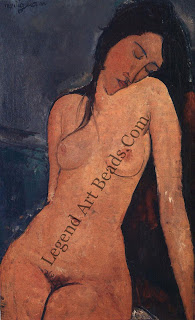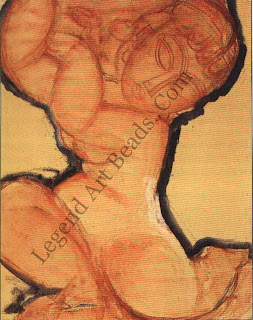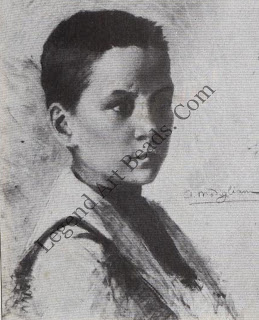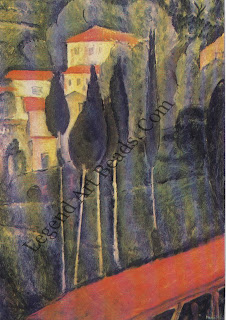Tradition with Modernism
Despite his limited subject matter of
portraits and nudes, Modigliani's work was unique in its combination of
traditional form with new painting techniques.
Portraits
and nudes established themselves as Modigliani's subjects from the beginning,
(he painted only a handful of landscapes).
He was not concerned with portraying
realistic appearances, but expressing the feeling and mood of his models,
especially in relation to himself. Most often, in the early part of his career,
tension and anxiety were the recurring motifs, probably echoing those features
in his own life at the time.
Living as a poverty-stricken foreigner in
Paris brought its own insecurities compounded by his feeling of alienation from
the avant-garde artists. His lack of money meant shortage of materials, so his
paint was spread thinly and he had to use both sides of the canvas.
Nonetheless, certain characteristics emerge as trademarks of his style as early
as 1908, fixing his own personal identity as an artist, and these are refined
into the elegance and poise of his last pictures. In his portraits sloping
shoulders and slender necks support gently tilting heads in which small mouths,
long noses and dark, introspective eyes are caught in a hypnotic expression.
 |
|
From
Italy, Modigliani carried with him the influences of Symbolism and Stile
Liberty (Art Nouveau) and his early works reflect this in mood and in their
linear pattern.
But in Paris, Modigliani discovered Cezanne at his
retrospective exhibition in 1907, and his debt to Cezanne is revealed in the construction
of his compositions in the arrangement of forms and isolation of planes through
color as well as his choppy brushstrokes. Although Cezanne had opened a new
direction in art leading to Cubism, he had never lost respect for the integrity
of the human form, which became central for Modigliani.
SCULPTURE OUT OF STONE
On
his return from summer in Livorno in 1909, Modigliani had decided to realize
his deep-seated ambition to become a sculptor. This is how he had introduced
himself on his arrival in Paris three years earlier. Between 1909 and 1914 he
produced barely twenty pictures. Inspired by the Rumanian sculptor, Brancusi,
whom he met in 1909 and next to whom he had a studio for a couple of years,
Modigliani was at work during these years on the remarkable heads that
integrate the concern for mass, volume and form that had initially attracted
him to Cezanne. The force of these mysterious faces lies in their inscrutable
expressions, and in their monumentality: one never forgets the rough-hewn
limestone block from which they have emerged. They also show a preoccupation
with the primitive sculptures of Africa and Oceania which Modigliani shared
with his contemporaries.

Modigliani
had always considered himself a painter-sculptor, having made his first
sculpture at Carrara in 1902, symbolically close to the quarries that had
provided Michelangelo with stone. In Paris, he carved the blocks that had been
begged or stolen from building sites. But he had never received any training in
sculpture and possessed neither the discipline nor the strength (the dust
irritated his lungs) to complete his ambitious project to construct a temple to
humanity adorned with pillars in the form of caryatids. Unable to find
materials in wartime, he ceased sculpting in 1914. The experience inevitably
fed his art, giving him a sure sense of form. In fact, his painting began to
take on the characteristics of his sculpture,
Especially
the modelled faces of his last portraits. The regret at this failure must have
cut deep. For in the combination of aggression and finesse that carving
demands, Modigliani may have found the best vehicle for his art of personal
feeling.
In
his portraits Modigliani showed keen insight into the character of the sitter,
a reflection of his own personal opinion. But his approach to nudes was different
he rarely painted lovers naked. Instead he used unprofessional models,
preferably servant girls. Interestingly, he always painted nudes in series,
showing he was working on them exclusively over a period of time. His nudes are
blatantly sensual and self confident and stand in the tradition of the genre,
alongside those of Titian, Goya and Renoir. Warm colors enhance the sensuous
undulating line that encloses the female form, buffeted by animated
brushstrokes. Unlike his portraits, their facial expressions seem all to be the
same.

His
confident use of line marks out the countless drawings Modigliani made through
his career. They were aide-ntemoires in which interesting compositions were
stored to be reused sometimes years later, although he never dispensed with a
model. Drawing was primarily the preliminary to painting. Jacques Lipchitz
recalled Modigliani making lots of drawings rapidly, seldom stopping 'to
correct or ponder'.
He would familiarize himself with his sitter in this way,
and gradually decide on a pose. When he subsequently turned to the canvas, he
worked quickly, 'interrupting only now and then to drink from a bottle standing
nearby'. His friend Lunia Czechowska noted that he worked best in a rage,
stoked by cheap brandy or rough red wine. The act of painting required an
immense emotional investment from the painter, who would move about, sigh
deeply and cry out in frustration. He worked intensively in order to complete
the picture at only one sitting.

A
year before he died, Modigliani went to the South of France. As models he used
local people and it may be that his impending paternity moved him to use
children as subjects. Here, too, he painted his rare landscapes. All of them
feature houses and trees he seemed to shy away from untouched nature. Despite
his dislike of the Mediterranean outdoors, his paintings during this period
have the airy luminosity of the south.
Modigliani's contribution to modern
art lies in his individuality. Unlike the artists of the avant-garde, for
example Picasso, he was not concerned with fragmenting form but in the
integrity of form in keeping with the tradition of the past. Yet his modernity
is reflected in his use of compositional devices which make his portraits
appear new and unique after all, it is impossible to confuse his work with any
other artists. Having no school, Modigliani has no successors.
THE MAKING OF A MASTERPIECE
Portrait of Jacques Lipchitz and his Wife
Both
Lipchitz and Modigliani were Jewish, middle class and sculptors, but they do
not appear to have been close friends which the portrait seems to reflect in
the formality of its composition.
In
1916, Lipchitz commissioned a portrait of himself and his new wife, Berthe,
from Modigliani, who informed him, 'My price is ten francs a sitting and a
little alcohol'. To familiarize himself with his sitters, Modigliani made
numerous drawings and the next day, set to work on an old, primed, canvas.
Working intensely, he had finished by the end of the afternoon. Lipchitz wanted
to pay him more, and so asked him to paint more 'substance'. 'If you want me to
spoil it,' came the reply, 'I can continue'. Modigliani gave another fortnight
to the picture.
Lipchitz did not like his portrait and kept it
in a closet until, in 1920, soon after Modigliani's death, he exchanged it for
some of his own earlier sculptures.
Writer-Marshall Cavendish

 His
confident use of line marks out the countless drawings Modigliani made through
his career. They were aide-ntemoires in which interesting compositions were
stored to be reused sometimes years later, although he never dispensed with a
model. Drawing was primarily the preliminary to painting. Jacques Lipchitz
recalled Modigliani making lots of drawings rapidly, seldom stopping 'to
correct or ponder'.
His
confident use of line marks out the countless drawings Modigliani made through
his career. They were aide-ntemoires in which interesting compositions were
stored to be reused sometimes years later, although he never dispensed with a
model. Drawing was primarily the preliminary to painting. Jacques Lipchitz
recalled Modigliani making lots of drawings rapidly, seldom stopping 'to
correct or ponder'.














0 Response to "Traditional art with Modernism by Modigliani"
Post a Comment